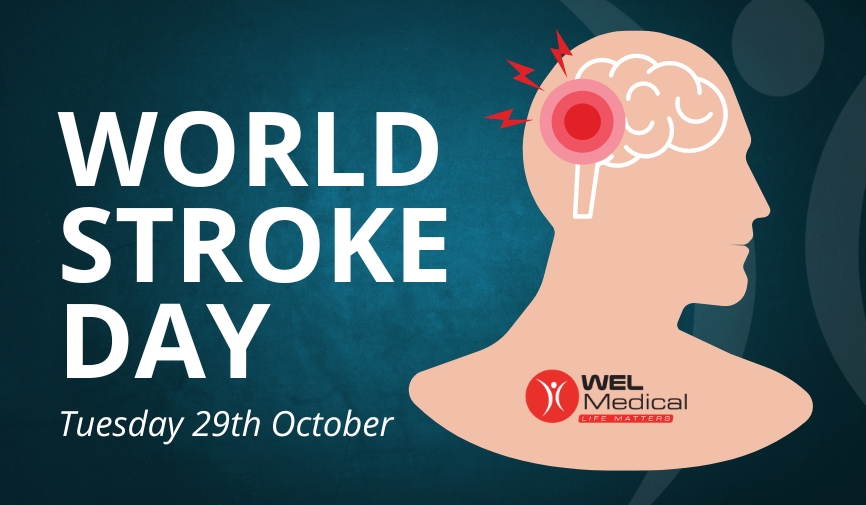Contents
ToggleAround 100,000 people have strokes every year in the UK. According to statistics from Brain Research UK, this accounts for as many as 34,000 deaths nationally, making it the fourth single leading cause of death.
Because of the prevalence of strokes, World Stroke Day is acknowledged on 29th October each year, and it’s a great opportunity to raise awareness of strokes. It’s also a time to highlight the links between strokes and cardiovascular health – something we at WEL Medical are passionate about kickstarting a conversation on. Understanding these links can help all of us to make informed decisions to safeguard our own wellbeing and minimise the risks of strokes.
What is a Stroke?
A stroke takes place when the blood supply to a part of the brain is disrupted – either by a blockage (an ischaemic stroke) or by bleeding (a haemorrhagic stroke). Without a steady flow of oxygen-rich blood, brain cells become damaged very quickly and can even die.
This, in turn, can lead to serious illness and death. The effects of a stroke can vary widely and depend on the severity of the stroke itself. The impact, however, is often severely life-altering.
What Are the Common Causes of Strokes?
There are many factors that can increase the risks of strokes. Some of the common causes of strokes overlap with those for other cardiovascular conditions, further displaying the links between heart health and strokes.
High Blood Pressure
High blood pressure or hypertension is one of the biggest risk factors when it comes to strokes. Having persistently high blood pressure causes excessive force against the walls of your arteries. Over time, this leads to the arteries gradually thickening and hardening – a condition known as arteriosclerosis.
This increased pressure makes the blood vessels less flexible and more prone to ruptures and blockages.
When the blood vessels in the brain are affected, it heightens the risk of both types of stroke. Over time, high blood pressure can also damage the inner lining of the arteries, which leads to plaque build-up that further narrows the vessels.
Atrial Fibrillation (AF)
AF is a common cardiac arrhythmia, or irregular heartbeat, that increases stroke risk significantly. During AF, the heart’s upper chambers (the atria) beat rapidly and irregularly, causing blood to pool and potentially form clots.
Image Source: SingHealth
If a clot forms in the left atrium, it can travel through the bloodstream to the brain, where it might block a cerebral artery, causing a stroke. AF-related strokes tend to be more severe than those from other causes, which is likely due to the size and location of the clots that form. Research shows us that people with AF are up to five times more likely to have a stroke than those without the condition.
Cholesterol
Cholesterol, particularly low-density lipoprotein (LDL), plays a big role in stroke risks. LDL cholesterol – often referred to as ‘bad cholesterol”, can accumulate on the walls of arteries, forming fatty deposits known as plaques. Much like high blood pressure, this can lead to arteriosclerosis, which reduces blood flow.
When these plaques become unstable, they can rupture, causing a blood clot to form. If this clot travels to the brain, it can block an artery and cause an ischaemic stroke. High levels of cholesterol are particularly dangerous in combination with other risk factors based around our lifestyles.
Image Source: Mass General Brigham
Lifestyle Factors
Lifestyle choices have a significant impact on stroke risk. Smoking introduces harmful chemicals into the bloodstream, like nicotine and carbon monoxide, which damage the lining of the arteries. Obesity and a lack of physical activity contribute to high blood pressure, high cholesterol, and diabetes, all of which have been linked to stroke risk.
A largely sedentary lifestyle also reduces circulation and increases the risk of blood clots. Excessive alcohol consumption can raise blood pressure, contribute to weight gain and cause heart rhythm problems like AF. Similarly, poor dietary habits, especially those high in salt and saturated fat, can elevate your blood pressure and cholesterol levels further.
Tips for Reducing the Chances of Strokes
To help prevent strokes and their health risks, building a stroke prevention or management plan is crucial. Many of these revolve around lifestyle changes, but making sure that you have lifesaving equipment like defibrillators on hand gives you added safety.
1. Monitor Your Blood Pressure
As we mentioned above, blood pressure is a leading cause of strokes. Regular monitoring and, if necessary, taking prescribed medication can lower the risk.
2. Exercise Regularly
Aim for at least 150 minutes of moderate exercise each week. Activities like walking, swimming, or cycling can all improve cardiovascular health.
3. Eat a Balanced Diet
A diet rich in fruits, vegetables, and whole grains supports heart health. Limiting salt, sugar, and saturated fats is also essential.
4. Quit Smoking
Smoking damages blood vessels and raises blood pressure. Quitting smoking is one of the most effective ways to bring down your risk of strokes.
5. Limit Alcohol Consumption
This doesn’t mean cutting it out altogether, but drinking to excess pushes up your blood pressure and the risk of a stroke. Moderation is key.
6. Manage Your Stress
Chronic stress can lead to unhealthy habits. Practising mindfulness, yoga, or simply taking time to relax can help to maintain emotional and physical wellbeing.
Want to Find Out More about the Links Between Heart Health and Strokes?
World Stroke Day reminds us that taking care of our cardiovascular health is crucial for reducing the risk of strokes. At WEL Medical, we are committed to raising awareness about stroke prevention and promoting a healthier lifestyle. Learn more about leading a heart-healthy lifestyle by visiting our News page where we regularly post tips.
If you want lifesaving equipment to keep your heart healthy and reduce the risks of strokes, then visit our shop page for AEDs, CPR training manikins, and more.
Alternatively, get in touch with us today to join in the conversation.









